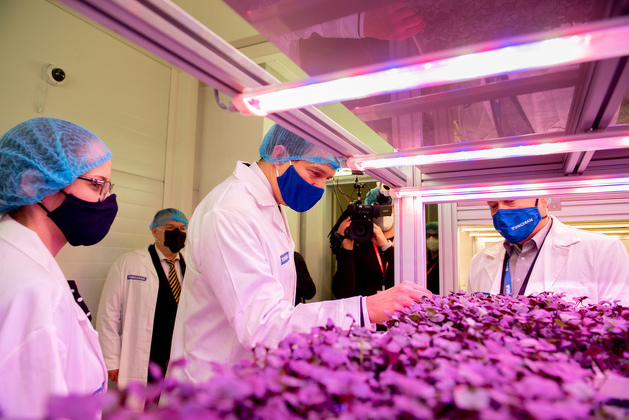An R&D purpose vertical farm unique in Central Europe was presented in Budapest, in the Újpest headquarters of the European lighting company, Tungsram.
The production area of the farm is 150 square metres where, in a hydroponic system, microgreens and baby leaves are grown exclusively under artificial, LED lighting regardless of the time of day or weather. While it is a commercial size, the focus of the facility is an R&D one which makes it unique in Central Europe. The area is complemented by two smaller growth chambers where the research activity takes place.
The Vertical Farming Institute defines vertical farming as the agricultural production inside buildings, in the metropolitan areas of our cities. Vertical Farming is therefore a form of urban agriculture. Because we are able to stack plantings, we are building vertically. Every square metre of floor space of vertical farming produces approximately the same amount of vegetable crops as 50 square metres of conventionally worked farmland.

“The cost of the development was 575 million Hungarian forints [approximately 1.6 million euro], 43,7 per cent of which was financed by ITM,” said State Secretary of the Ministry for Innovation and Technology László György during the opening ceremony of Hungary’s unique vertical farm, referring to the Ministry’s project called Indoor agriculture – setting up a vertical farm. “The farm is 100 per cent Hungarian developed and produced.”
Indeed, the farm was realised by KÉSZ Group, a major Hungarian construction industry operator, with the commercial partnership of producer of ready-to-eat salads Eisberg and using the biotechnology know-how of Biopólus, a Hungarian urban planner and technology provider. The lamps and technology were provided by the Nagykanizsa and Hajdúböszörmény plants of Tungsram.
“Currently the facility provides work for 9 people, mainly researchers thus vertical farms will offer new, value-added job opportunities nation-wide”, added the State Secretary. “The goal is Hungary to claim back its original position in the five biggest agricultural research countries based on its knowledge.”
Tungsram can show the entire technology and the result of it (quantity, colour, taste of plants) for future customers as the main goal is to sell and build similar, complete farm systems for other growers.
Indeed, the lack of food will not only a Hungarian challenge. According to the United Nations, the world’s population is expected to increase by 2 billion persons in the next 30 years, from 7.7 billion currently to 9.7 billion in 2050. Combined with the fact that nearly 33 per cent of the world’s arable land has been lost to erosion or pollution in the last 40 years and that conventional industrial agriculture is not sustainable anymore, innovative and new solutions must be found.
“This technology that can be one of the solutions for the global food security problem is the opportunity of our generation,” stated Tungsram President & CEO Joerg Bauer. “One of the factors of growth is that in 10 years – because of climate change, urbanisation and population increase – the world will need to provide 50 per cent more food than now. All while arable lands are drastically decreasing.”
According to Tunsgram, indoor farming can serve as an alternative for the food security of the world, however, a huge development is necessary to be able to mass-produce grains, rice, corn this way.
Vertical farms have several advantages, such as a drastic reduction of water and fertilisers usage. However, they could also be very expensive to build and, as vertical farming takes place in a controlled environment without the presence of insects, the pollination process needs to be done manually, which will be labour-intensive and costly.
Tungsram could overcome these challenges by exploiting its ties with several Hungarian universities. During the negotiations, even the idea of a university faculty outsourced to a Tungsram plant was brought up as this technology is worth being naturalised in Hungary and introduced to the experts of the future.
As the European Commission’s Farm to Fork strategy underlines, it is clear that the transition will not happen without a shift in people’s diets: if European diets were in line with dietary recommendations, the environmental footprint of food systems would be significantly reduced.
Photos: Tungsram.



